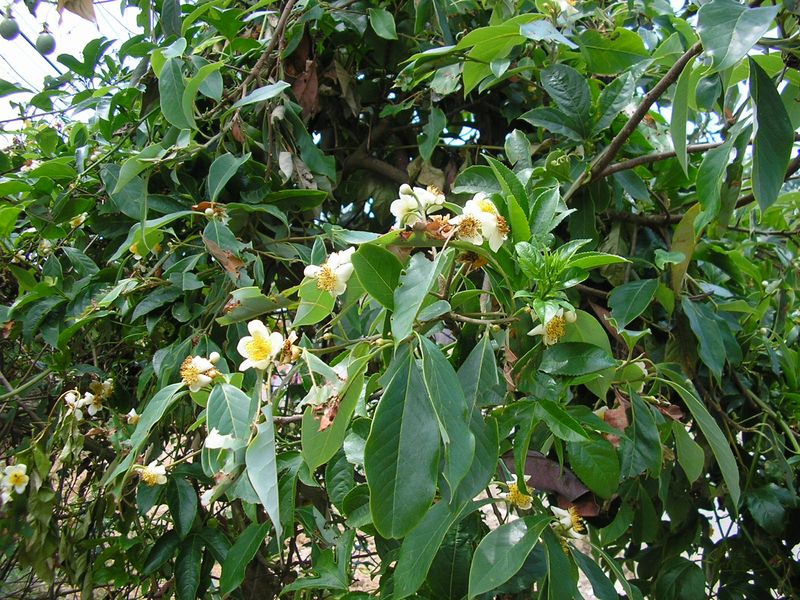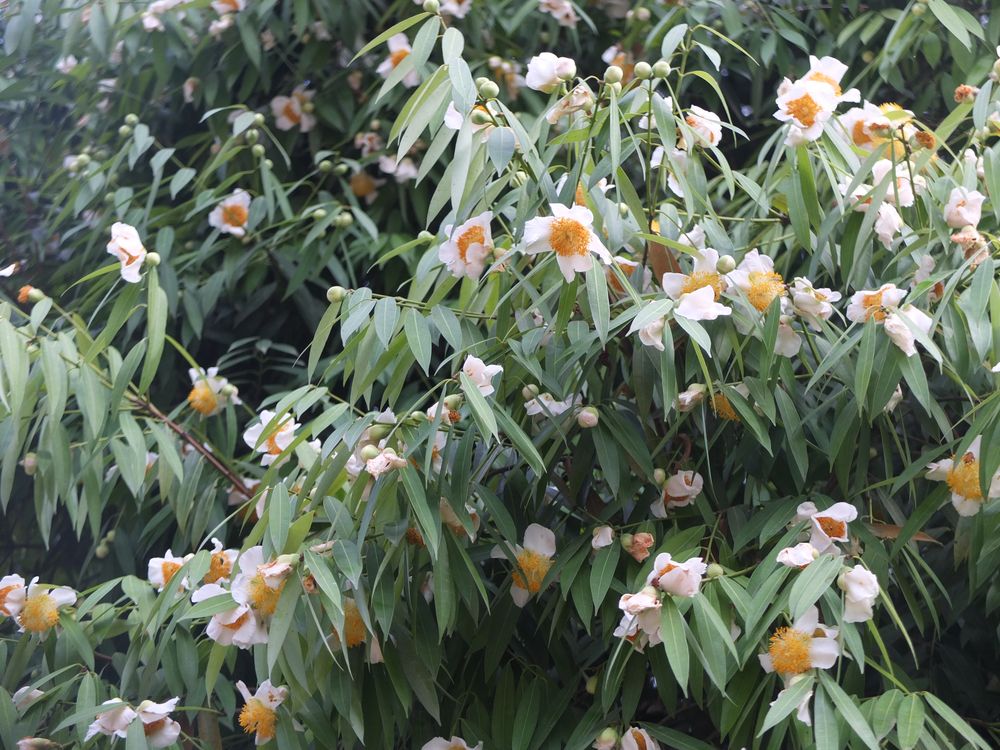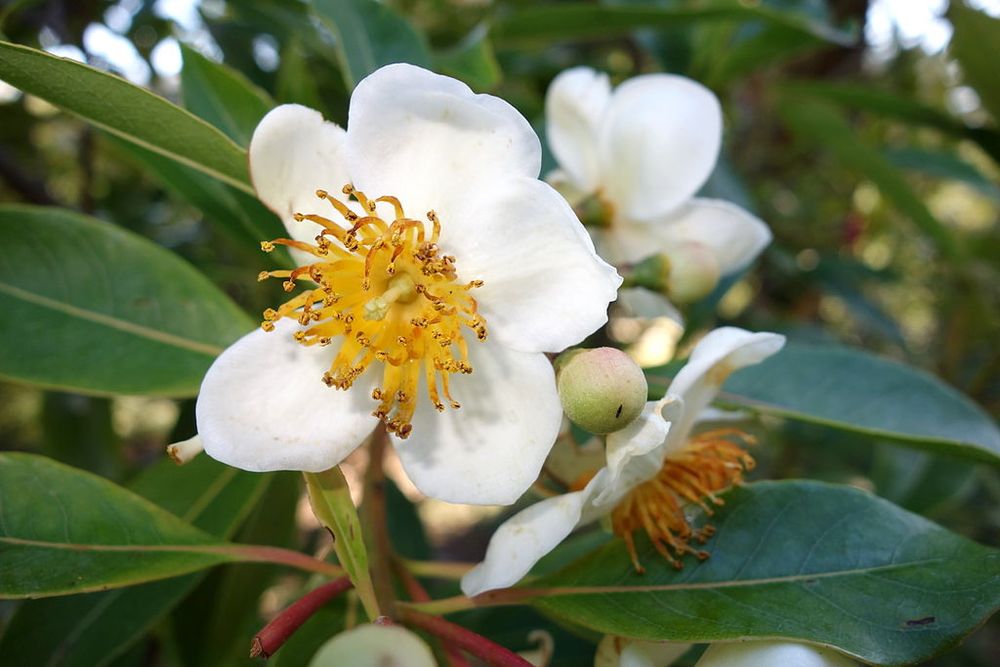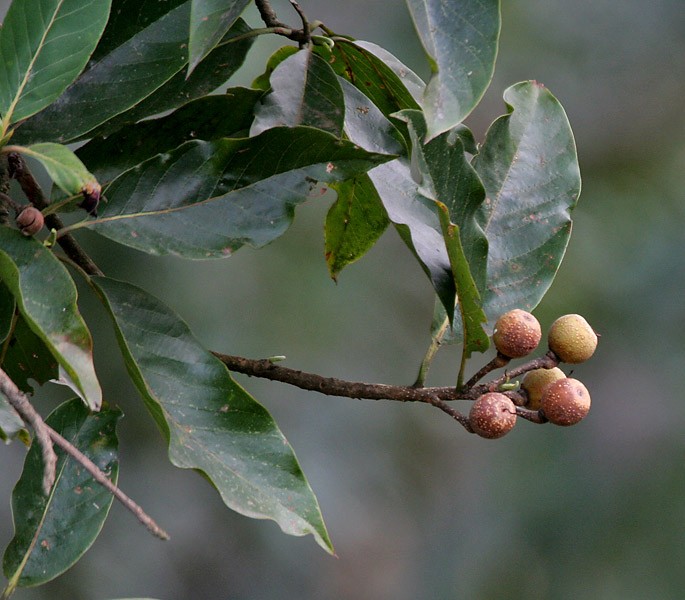The tree is not widely cultivated outside its native region, which extends from India to the Philippines. It is sometimes given its scientific name, Schima, which means “shady” in Greek. In Laos, it is found mainly in the north, at medium altitude. Its leaves are elongated, dark green, rigid and shiny. Its pretty, fragrant white flowers have 5 petals and numerous yellow stamens in a puff, reminiscent of the flowers of the European Eglantine; they appear at the end of the dry season and the small globular fruits take 8 months to form.
The tree is interesting for its wood, mai mi, which is not very hard, but very resistant and is rarely attacked by termites; it can be worked by hand quite easily and polishes well. It is traditionally used for house posts and fences, but also for everyday household items, agricultural tools, parts of boats, light mountain bridges, and even rafts.
The leaves of tone mi are sometimes used as roofing for houses and as stoppers for some containers, especially in dyeing techniques. The whole plant contains tannin and the ash-like bark is added to the indigo paste. However the bark also contains an alkaloid which is used to poison fish and which, when burnt, gives off a very irritating smoke. Moreover, superstitious mountain people burn this wood in houses where they are afraid of “men who turn into tigers”, because the smoke, which burns the eyes, keeps them at bay. In very small doses, however, its smell is pleasant and it is ground into a powder and added to incense.
Tone mi has medicinal properties: the dried flowers, macerated in water or infused, are drunk to treat convulsions and epilepsy, and are a sweet drink for women who have just given birth. The stems in decoction are said to calm nausea.
If we add to all the qualities of Schima wallichii the fact that it adapts well to poor soils and grows quickly, we will understand why the Lao government, through the NAFRI project, recommends the planting of this tree to combat deforestation. In optimal forest agriculture, it preserves the soil, and its shade can be used for market gardening or even coffee growing. Industrial exploitation of this wood, which is in demand elsewhere, is also possible.
Cet arbre est peu cultivé en dehors de sa région d’origine qui va de l’Inde aux Philippines. On lui donne parfois son nom scientifique, Schima, qui signifie en grec « ombreux ». Au Laos, on le trouve surtout dans le Nord, en moyenne altitude. Ses feuilles sont allongées, verts foncé, rigides et brillantes. Ses jolies fleurs blanches odorantes ont 5 pétales et de nombreuses étamines jaunes en houppette, elles rappellent les fleurs d’Eglantine européenne ; elles apparaissent à la fin de la saison sèche et les petits fruits globuleux mettront 8 mois pour se former.
Cet arbre est intéressant pour son bois, mai mi, qui n’est pas très dur, mais très résistant et qui, en outre, n’est que rarement attaqué par les termites ; il peut être travaillé à la main assez facilement et se polit bien. Il est utilisé traditionnellement pour les poteaux des habitations et les clôtures, mais aussi pour les objets courants de la maison, les outils agricoles, certaines parties des bateaux, les ponts légers de montagne, et même les radeaux.
Les feuilles de tone mi servent parfois pour la couverture des habitations et comme bouchon de certains récipients, en particulier dans les techniques de teinture. Toute la plante contient du tanin et l’écorce réduite en cendre est ajoutée à la pâte d’indigo. Mais cette écorce contient aussi un alcaloïde qui sert à empoisonner le poisson et qui, en brûlant, dégage une fumée très irritante. D’ailleurs, les montagnards superstitieux, brûlent ce bois dans les maisons où l’on a peur « des hommes qui se transforment en tigre », parce que la fumée qui brûle les yeux, les tient à distance. A très petite dose cependant son odeur est agréable et réduite en poudre elle est ajoutée à l’encens.
Tone mi a des vertus médicinales : les fleurs séchées, macérées dans l’eau ou infusées sont bues pour soigner les convulsions, l’épilepsie, et constituent une boisson douce pour les femmes qui viennent d’accoucher. Les tiges en décoction calmeraient les nausées.
Si l’on ajoute à toutes les qualités de Schima wallichii celle de bien s’adapter aux sols pauvres, et de pousser rapidement, on comprendra que le gouvernement lao, à travers le projet NAFRI, préconise la plantation de cet arbre pour lutter contre la déforestation. Dans une agriculture forestière optimale il permet de préserver les sols, et son ombre peut servir à abriter des cultures maraîchères ou même celle du café. On peut aussi envisager une exploitation industrielle de ce bois assez recherché ailleurs.




The tree is not widely cultivated outside its native region, which extends from India to the Philippines. It is sometimes given its scientific name, Schima, which means “shady” in Greek. In Laos, it is found mainly in the north, at medium altitude. Its leaves are elongated, dark green, rigid and shiny. Its pretty, fragrant white flowers have 5 petals and numerous yellow stamens in a puff, reminiscent of the flowers of the European Eglantine; they appear at the end of the dry season and the small globular fruits take 8 months to form.
The tree is interesting for its wood, mai mi, which is not very hard, but very resistant and is rarely attacked by termites; it can be worked by hand quite easily and polishes well. It is traditionally used for house posts and fences, but also for everyday household items, agricultural tools, parts of boats, light mountain bridges, and even rafts.
The leaves of tone mi are sometimes used as roofing for houses and as stoppers for some containers, especially in dyeing techniques. The whole plant contains tannin and the ash-like bark is added to the indigo paste. However the bark also contains an alkaloid which is used to poison fish and which, when burnt, gives off a very irritating smoke. Moreover, superstitious mountain people burn this wood in houses where they are afraid of “men who turn into tigers”, because the smoke, which burns the eyes, keeps them at bay. In very small doses, however, its smell is pleasant and it is ground into a powder and added to incense.
Tone mi has medicinal properties: the dried flowers, macerated in water or infused, are drunk to treat convulsions and epilepsy, and are a sweet drink for women who have just given birth. The stems in decoction are said to calm nausea.
If we add to all the qualities of Schima wallichii the fact that it adapts well to poor soils and grows quickly, we will understand why the Lao government, through the NAFRI project, recommends the planting of this tree to combat deforestation. In optimal forest agriculture, it preserves the soil, and its shade can be used for market gardening or even coffee growing. Industrial exploitation of this wood, which is in demand elsewhere, is also possible.
Cet arbre est peu cultivé en dehors de sa région d’origine qui va de l’Inde aux Philippines. On lui donne parfois son nom scientifique, Schima, qui signifie en grec « ombreux ». Au Laos, on le trouve surtout dans le Nord, en moyenne altitude. Ses feuilles sont allongées, verts foncé, rigides et brillantes. Ses jolies fleurs blanches odorantes ont 5 pétales et de nombreuses étamines jaunes en houppette, elles rappellent les fleurs d’Eglantine européenne ; elles apparaissent à la fin de la saison sèche et les petits fruits globuleux mettront 8 mois pour se former.
Cet arbre est intéressant pour son bois, mai mi, qui n’est pas très dur, mais très résistant et qui, en outre, n’est que rarement attaqué par les termites ; il peut être travaillé à la main assez facilement et se polit bien. Il est utilisé traditionnellement pour les poteaux des habitations et les clôtures, mais aussi pour les objets courants de la maison, les outils agricoles, certaines parties des bateaux, les ponts légers de montagne, et même les radeaux.
Les feuilles de tone mi servent parfois pour la couverture des habitations et comme bouchon de certains récipients, en particulier dans les techniques de teinture. Toute la plante contient du tanin et l’écorce réduite en cendre est ajoutée à la pâte d’indigo. Mais cette écorce contient aussi un alcaloïde qui sert à empoisonner le poisson et qui, en brûlant, dégage une fumée très irritante. D’ailleurs, les montagnards superstitieux, brûlent ce bois dans les maisons où l’on a peur « des hommes qui se transforment en tigre », parce que la fumée qui brûle les yeux, les tient à distance. A très petite dose cependant son odeur est agréable et réduite en poudre elle est ajoutée à l’encens.
Tone mi a des vertus médicinales : les fleurs séchées, macérées dans l’eau ou infusées sont bues pour soigner les convulsions, l’épilepsie, et constituent une boisson douce pour les femmes qui viennent d’accoucher. Les tiges en décoction calmeraient les nausées.
Si l’on ajoute à toutes les qualités de Schima wallichii celle de bien s’adapter aux sols pauvres, et de pousser rapidement, on comprendra que le gouvernement lao, à travers le projet NAFRI, préconise la plantation de cet arbre pour lutter contre la déforestation. Dans une agriculture forestière optimale il permet de préserver les sols, et son ombre peut servir à abriter des cultures maraîchères ou même celle du café. On peut aussi envisager une exploitation industrielle de ce bois assez recherché ailleurs.








The tree is not widely cultivated outside its native region, which extends from India to the Philippines. It is sometimes given its scientific name, Schima, which means “shady” in Greek. In Laos, it is found mainly in the north, at medium altitude. Its leaves are elongated, dark green, rigid and shiny. Its pretty, fragrant white flowers have 5 petals and numerous yellow stamens in a puff, reminiscent of the flowers of the European Eglantine; they appear at the end of the dry season and the small globular fruits take 8 months to form.
The tree is interesting for its wood, mai mi, which is not very hard, but very resistant and is rarely attacked by termites; it can be worked by hand quite easily and polishes well. It is traditionally used for house posts and fences, but also for everyday household items, agricultural tools, parts of boats, light mountain bridges, and even rafts.
The leaves of tone mi are sometimes used as roofing for houses and as stoppers for some containers, especially in dyeing techniques. The whole plant contains tannin and the ash-like bark is added to the indigo paste. However the bark also contains an alkaloid which is used to poison fish and which, when burnt, gives off a very irritating smoke. Moreover, superstitious mountain people burn this wood in houses where they are afraid of “men who turn into tigers”, because the smoke, which burns the eyes, keeps them at bay. In very small doses, however, its smell is pleasant and it is ground into a powder and added to incense.
Tone mi has medicinal properties: the dried flowers, macerated in water or infused, are drunk to treat convulsions and epilepsy, and are a sweet drink for women who have just given birth. The stems in decoction are said to calm nausea.
If we add to all the qualities of Schima wallichii the fact that it adapts well to poor soils and grows quickly, we will understand why the Lao government, through the NAFRI project, recommends the planting of this tree to combat deforestation. In optimal forest agriculture, it preserves the soil, and its shade can be used for market gardening or even coffee growing. Industrial exploitation of this wood, which is in demand elsewhere, is also possible.
Cet arbre est peu cultivé en dehors de sa région d’origine qui va de l’Inde aux Philippines. On lui donne parfois son nom scientifique, Schima, qui signifie en grec « ombreux ». Au Laos, on le trouve surtout dans le Nord, en moyenne altitude. Ses feuilles sont allongées, verts foncé, rigides et brillantes. Ses jolies fleurs blanches odorantes ont 5 pétales et de nombreuses étamines jaunes en houppette, elles rappellent les fleurs d’Eglantine européenne ; elles apparaissent à la fin de la saison sèche et les petits fruits globuleux mettront 8 mois pour se former.
Cet arbre est intéressant pour son bois, mai mi, qui n’est pas très dur, mais très résistant et qui, en outre, n’est que rarement attaqué par les termites ; il peut être travaillé à la main assez facilement et se polit bien. Il est utilisé traditionnellement pour les poteaux des habitations et les clôtures, mais aussi pour les objets courants de la maison, les outils agricoles, certaines parties des bateaux, les ponts légers de montagne, et même les radeaux.
Les feuilles de tone mi servent parfois pour la couverture des habitations et comme bouchon de certains récipients, en particulier dans les techniques de teinture. Toute la plante contient du tanin et l’écorce réduite en cendre est ajoutée à la pâte d’indigo. Mais cette écorce contient aussi un alcaloïde qui sert à empoisonner le poisson et qui, en brûlant, dégage une fumée très irritante. D’ailleurs, les montagnards superstitieux, brûlent ce bois dans les maisons où l’on a peur « des hommes qui se transforment en tigre », parce que la fumée qui brûle les yeux, les tient à distance. A très petite dose cependant son odeur est agréable et réduite en poudre elle est ajoutée à l’encens.
Tone mi a des vertus médicinales : les fleurs séchées, macérées dans l’eau ou infusées sont bues pour soigner les convulsions, l’épilepsie, et constituent une boisson douce pour les femmes qui viennent d’accoucher. Les tiges en décoction calmeraient les nausées.
Si l’on ajoute à toutes les qualités de Schima wallichii celle de bien s’adapter aux sols pauvres, et de pousser rapidement, on comprendra que le gouvernement lao, à travers le projet NAFRI, préconise la plantation de cet arbre pour lutter contre la déforestation. Dans une agriculture forestière optimale il permet de préserver les sols, et son ombre peut servir à abriter des cultures maraîchères ou même celle du café. On peut aussi envisager une exploitation industrielle de ce bois assez recherché ailleurs.


